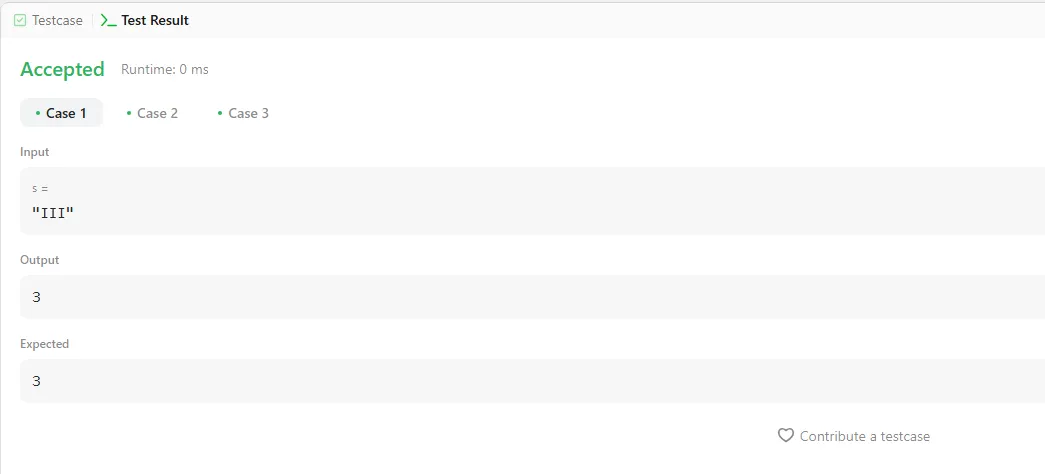Roman numerals are represented by seven different symbols: I, V, X, L, C, D and M.
SymbolValue
I 1
V 5
X 10
L 50
C 100
D 500
M 1000
Plain Text
복사
For example, 2 is written as II in Roman numeral, just two ones added together. 12 is written as XII, which is simply X + II. The number 27 is written as XXVII, which is XX + V + II.
Roman numerals are usually written largest to smallest from left to right. However, the numeral for four is not IIII. Instead, the number four is written as IV. Because the one is before the five we subtract it making four. The same principle applies to the number nine, which is written as IX. There are six instances where subtraction is used:
•
I can be placed before V (5) and X (10) to make 4 and 9.
•
X can be placed before L (50) and C (100) to make 40 and 90.
•
C can be placed before D (500) and M (1000) to make 400 and 900.
Given a Roman numeral, convert it to an integer.
Example 1:
Input: s = "III"
Output: 3
Explanation: III = 3.
Plain Text
복사
Example 2:
Input: s = "LVIII"
Output: 58
Explanation: L = 50, V= 5, III = 3.
Plain Text
복사
Example 3:
Input: s = "MCMXCIV"
Output: 1994
Explanation: M = 1000, CM = 900, XC = 90 and IV = 4.
Plain Text
복사
Constraints:
•
1 <= s.length <= 15
•
s contains only the characters ('I', 'V', 'X', 'L', 'C', 'D', 'M').
•
It is guaranteed that s is a valid roman numeral in the range [1, 3999].
class Solution:
def romanToInt(self, s: str) -> int:
numbers = {
"I":1,
"V":5,
"X":10,
"L":50,
"C":100,
"D":500,
"M":1000
}
sum = 0
i = 0
while i < len(s):
if i + 1 < len(s) and numbers.get(s[i]) < numbers.get(s[i + 1]):
# 1) i + 1 < len(s): Check if there is a next character to avoid index out-of-range errors
# 2) numbers[s[i]] < numbers[s[i + 1]]:
# If the current value is smaller than the next value, apply the Roman numeral subtraction rule
# Examples: IV=4, IX=9, XL=40, XC=90, CD=400, CM=900
sum += numbers.get(s[i + 1]) - numbers.get(s[i])
i += 2
else:
sum += numbers.get(s[i])
i += 1
return sum
Python
복사
Initially, I iterated through the string s and, whenever a character matched a key in the dictionary, I added the corresponding value. This works for simple cases like III, but it fails for subtractive notation such as IV. For instance, IV should be 4, but a naive sum would produce 1 + 5 = 6.
To fix this, I applied the subtraction rule. Specifically, if there is a next character (i + 1 < len(s)) and the next value is greater than the current one (e.g., I followed by V or X), I treat the two characters as a pair and add (next − current). Since two characters are consumed at once, I advance the index by two (i += 2).
Otherwise (when the next value is less than or equal to the current), I simply add the current value and move forward by one (i += 1). With this logic, III becomes 1 + 1 + 1 = 3, and IV becomes (5 − 1) = 4, as expected.
(Note: In traditional Roman numerals, subtraction is only allowed for specific pairs: I before V/X, X before L/C, and C before D/M.)
I ran the code, and it passed all the test cases.
And when I submitted it, I might have been lucky enough to get it accepted. I looked for solutions from others to see if there was an approach without using a dictionary, but everyone I saw used a dictionary. If the dictionary’s values had to change dynamically, I think it would result in inefficient code.









